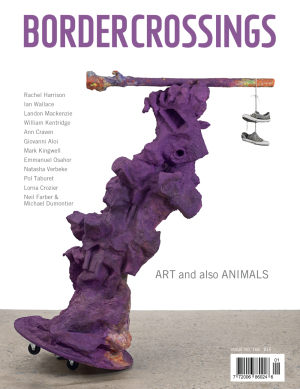Luther Konadu: Meta Pics
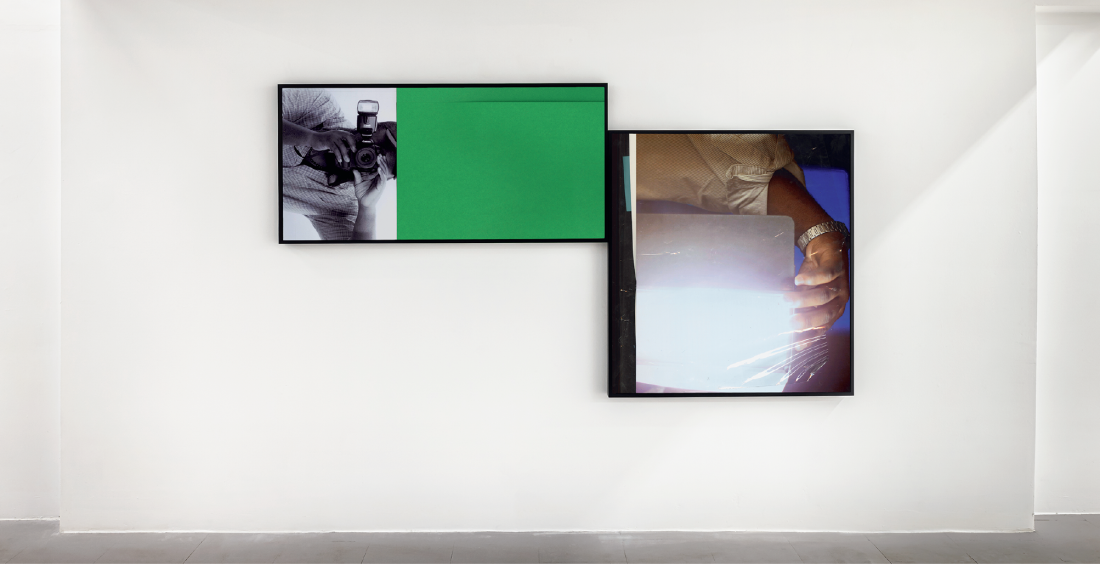
Luther Konadu, installation view, “Ambient Photo,” 2025, two seven two gallery, Toronto. All photos by Toni Hafkenscheid. All images courtesy two seven two gallery, Toronto. Left to right: Untitled, 2025, archival mounted on 3 mm Alupanel and black lacquered maple wood shadow box frame with glass, frame: 119.38 × 56.77 centimetres; Untitled, 2025, archival mounted on 3 mm Alupanel and black lacquered maple wood shadow box frame with glass, frame: 88.9 × 96.52 centimetres.
Winnipeg-based photographer Luther Konadu is a quiet force of culture. He is the artistic director of C-Cap (the Centre for Cultural and Artistic Practices), as well as the founding editor of Public Parking, an online magazine he started in 2016, which he describes as “a journal for storytelling, arguments and discovery through tangential conversations.” His most recent exhibition of photographs, called “Ambient Photo,” at two seven two gallery in Toronto shows these interests operating in compelling ways. A quick look at Konadu’s photographs suggests that he is working within the tradition of documentary, a mode of picture taking that is seen as a reliable description of the way things look and what they mean. The subjects in his photographs are exclusively friends who are members of Winnipeg’s Black diasporic community whom he photographs and rephotographs in his studio.

Untitled, 2025, archival mounted on 3 mm Alupanel and black lacquered maple wood shadow box frame with glass, frame: 53.34 × 66.04 centimetres.
All the conditions are present for him to make documentary photographs, and Konadu is acutely aware of that tradition. “From the beginning I thought of myself as someone making portraits with the camera, but the idea of portraiture became more theoretical.” A similar shift occurred in his thinking about documentary: “Documentary pursues things like history and anthropology, and what interests me is how I can subvert that in some way.” As a result, all his compositions are subversions. “Because I don’t know what a straightforward rendition of reality is, I have an antagonistic relationship with the medium,” he says. “So my photography is a commentary on and a conversation with the medium of documentary photography itself. I am always interested in interrupting a discernible read of what’s being photographed and also having the machinations of the medium be more in the forefront and more apparent than whatever else is in the image.”

Untitled, 2025, archival mounted on 3 mm Alupanel and custom cherry wood shadow box frame with glass, left frame: 50.8 × 63.5 centimetres, middle frame: 48.9 × 56.2 centimetres; right frame: 93.35 × 56.2 centimetres.
He also wants to subvert time in his photographs; his method is to go into his own archive and retrieve images that can be anywhere from five to eight years old, which he then combines on the same picture plane with photographs he has taken only months before. The resulting image makes no narrative or sequential connection among its component parts. “You’re not looking at just one moment in time,” he says, “but an accumulation of time pointing to different moments.” In any exhibition, he will also use multiples of the same image, enlarge and crop them, and orient them differently in space. His inclination not to see any single image as conclusive encourages him to return to his archive and reuse what is there. He is a not-overly-determined Spenglerian. “I definitely like the idea of the return with a difference and how repetition can have its own nuances and its own variations.”
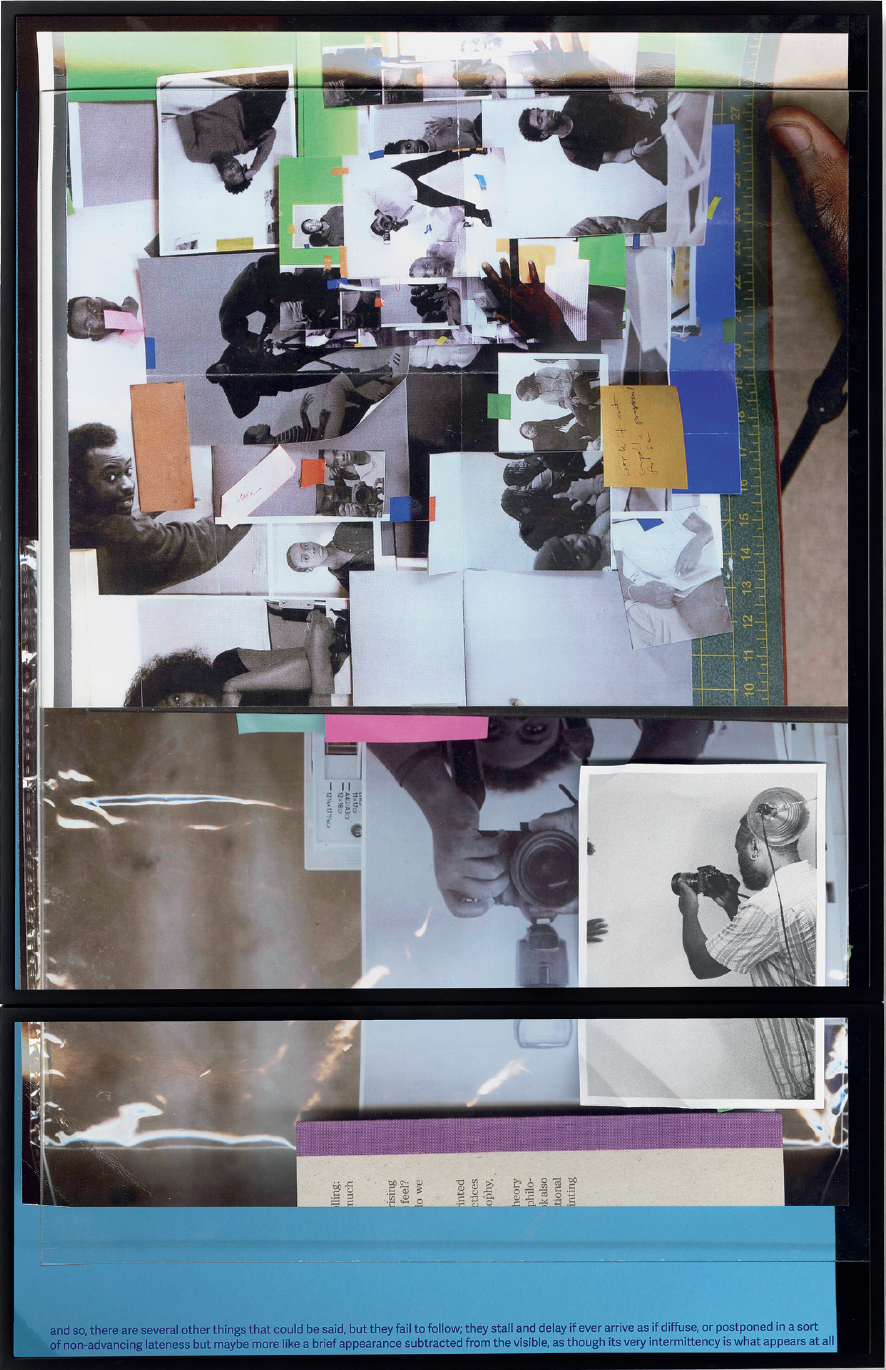
Untitled, 2025, archival mounted on 3 mm Alupanel and black lacquered maple wood shadow box frame with glass, top frame: 82.55 × 93.98 centimetres; bottom frame: 82.55 × 33.02 centimetres.
One of his repeated compositional strategies is a trope of presentation. On their surface, these images show you something: a hand holds up a piece of paper; a yellow file folder sits in front of a pair of blurry background images; a pink folded sheet of paper with a text draws our attention away from a cluster of photographs behind it. What looks like information is a kind of decoy, and the act of showing becomes the art of not revealing. The white sheet of paper has no content, the text on the file folder says, “you are speckled across endless space,” and the background figures are so out of focus that you can hardly read them.
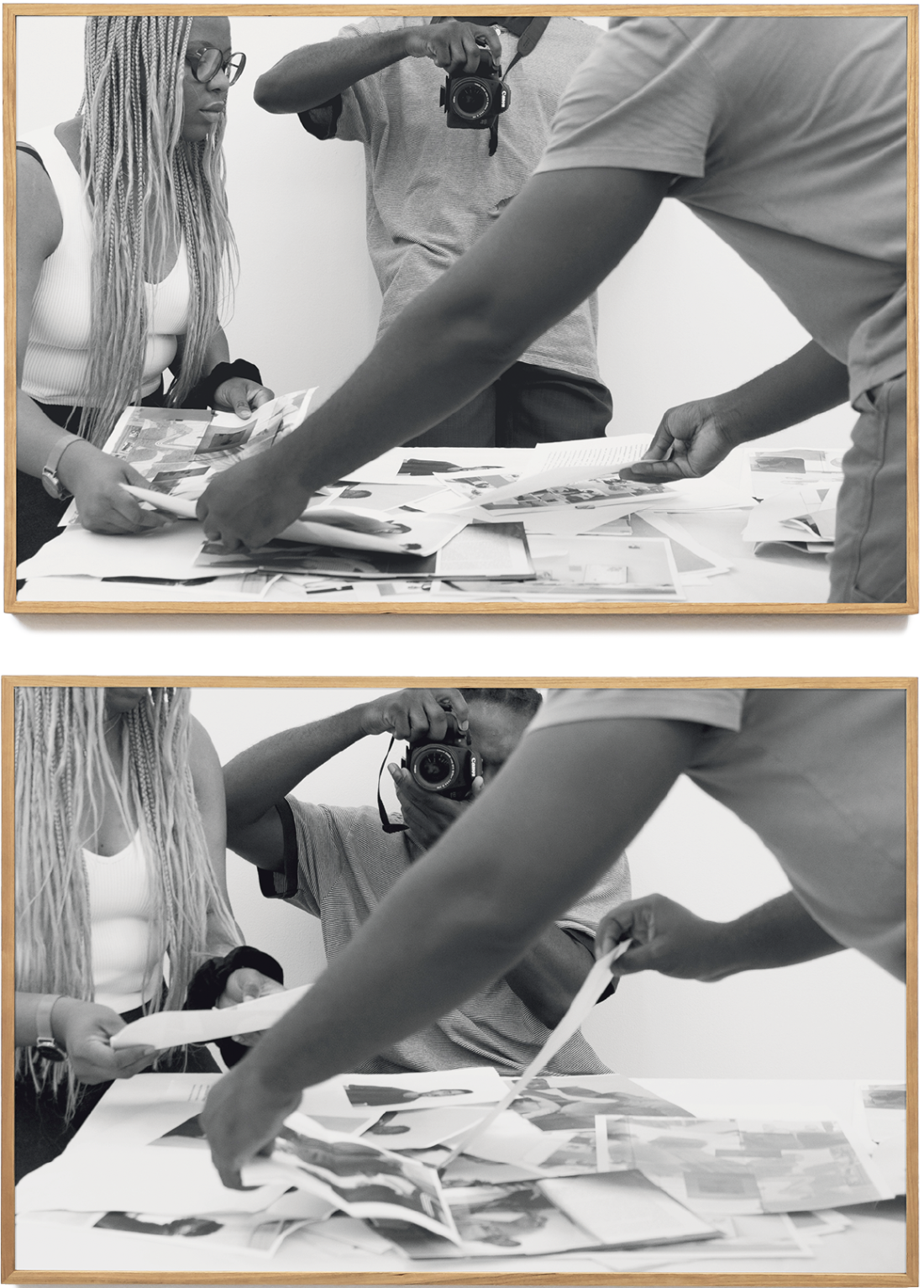
Untitled, 2025, archival mounted on 3 mm Alupanel and maple wood shadow box frame with glass, each frame: 58.42 × 88.9 centimetres.
When his pictures contain texts, in every case the language is allusive and elusive. The folded pink paper text opens with a line that is about both physics and the physical act of making photographs: “Right at this very moment, the universe is making other universes, it is expanding in all directions at a constant speed. The expanse of this will mainly be used as a storage unit.” The storage unit is an archive, and Konadu understands that it will “remain patternless, eluding measurement, imaging, or a designation into language.” The text on the image is the aesthetic in the artist. In one relatively uncomplicated picture—all his photographs are untitled—we see Konadu photographing something. We can make out his figure, but what is more prominent is an obliterating flash of light that begins in the lower right-hand side of the image and increases in size until it “disfigures” the photographer. Then Konadu goes one step further. He takes the vertical format of the image and turns it on its horizontal edge. The effect unsimplifies a simple picture. He can also deliver a surplus, as he does in pictures that resemble the kind of visually dense bulletin boards artists have in their studio where they arrange inspirational works by other artists. Konadu’s board is a patchwork of coloured paper fragments and unrelated black and white photographs.
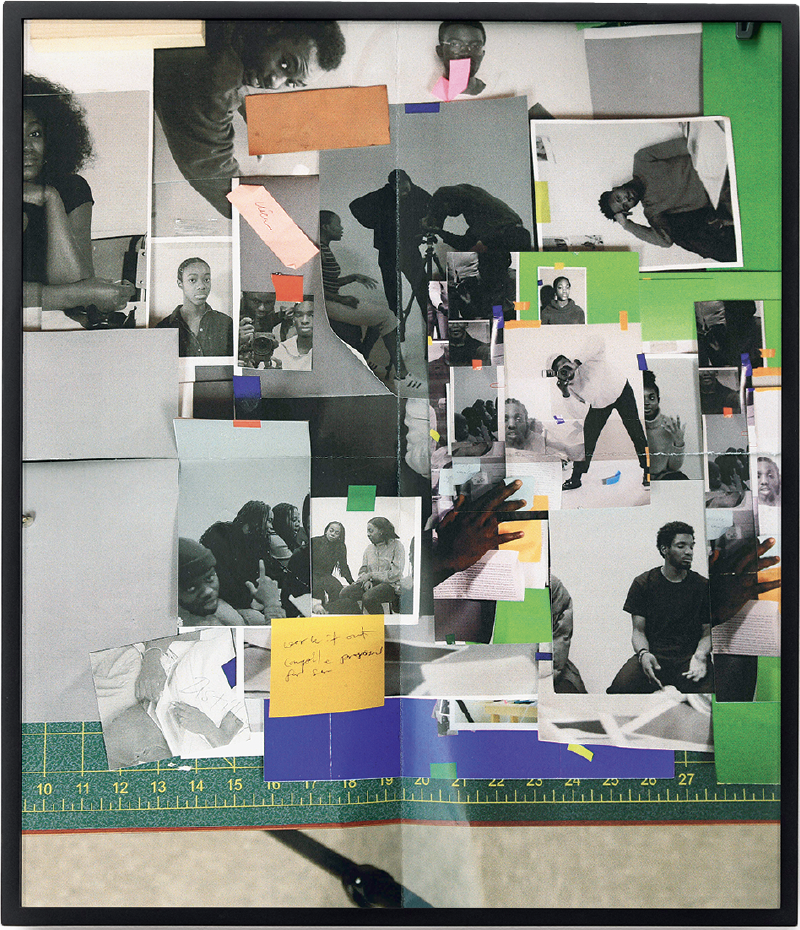
Untitled, 2025, archival mounted on 3 mm Alupanel and black lacquered maple wood shadow box frame with glass, frame: 53.34 × 66.04 centimetres.
What he consistently makes clear is that the subject of his photographs is not what he is shooting but the fact that he is shooting. His subject is photography itself and the nature of representation. It follows from this conceptual strategy that many of his pictures have a meta-photographic dimension. In one two-part, over-and-under configuration, Konadu photographs a friend who is sifting through a pile of images left on a table. The photograph is a documentary trace of a methodology of picture making. The man is doing exactly what Konadu does when he decides how, and with what, he will make an image. The doubled photograph does double duty.

Untitled, 2025, archival mounted on 3 mm Alupanel and black lacquered maple wood shadow box frame with glass, frame: 40.64 × 53.34 centimetres.
For all his compulsion to subvert our conventional read of photography and its relationship to representation, there is one aspect of the image he won’t undermine. Konadu’s photographs are elegantly designed and carefully composed, and his installations are meticulously planned. He is as seduced by beauty as he wants us to be. His use of colour is one of the principal ways he attracts our attention. The blue and green areas that constitute large sections of his pictures are backdrops that are commonly used in photographic studios, but he employs them the way a painter would; the intensity of the colour is a way to keep you on the outside of the composition. They are not a window into a space as much as they are the space itself. Konadu’s beauty sits on the surface.
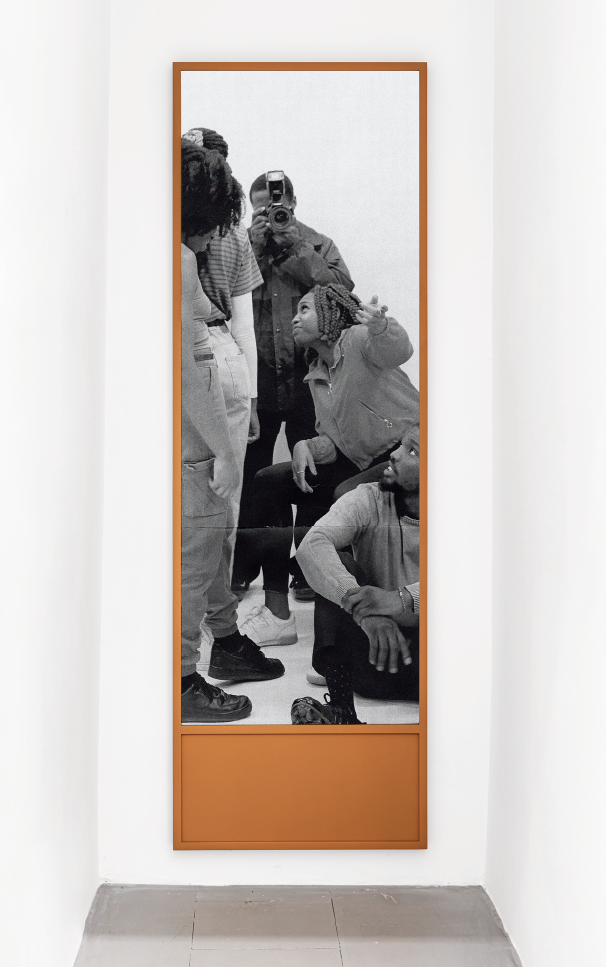
Untitled, 2025, archival mounted on 3 mm Alupanel and black lacquered maple wood shadow box frame with glass, frame: 55.88 × 176.37 centimetres.
One of his texts asks, “What happens when an observation becomes an obstacle to knowing?” It is selfdirected; the observations he makes with his camera are embodied askings of exactly that question, and their presence as images proposes the same answer. His pictures encourage us to slow down our perception and look closely at what he has assembled. Konadu’s pictures are quandaried—wilfully and intelligently. It’s not that they don’t give us something on the surface (they actually give a great deal), but what they give is not what you think you’re getting. He talks about his photography as “a pursuit that doesn’t amount to anything solid or definitive.” In support of this idea, he moves from art to meteorology and concentrates on a substance that transforms into an atmosphere. “Virga” is precipitation that evaporates before it reaches the ground. In a text included on another of his photographs, Konadu writes about it as matter “expressed as vapour—an ambience, a patternless knowledge.” In the astronomical zone charted by his photography, Luther Konadu operates in ineffable space, under the sign of Virga. ❚
“Ambient Photo” was on exhibition at two seven two gallery in Toronto from February 26, 2025, to April 12, 2025.

